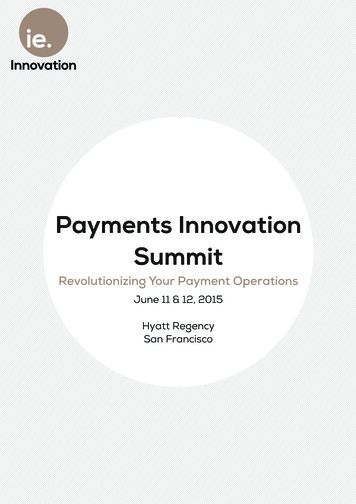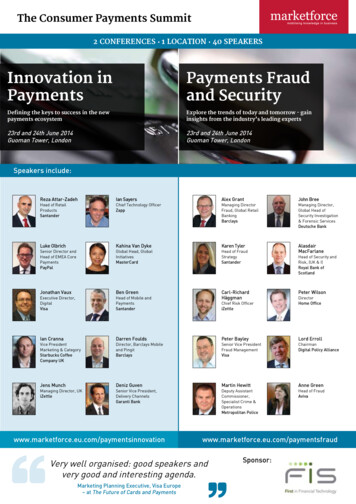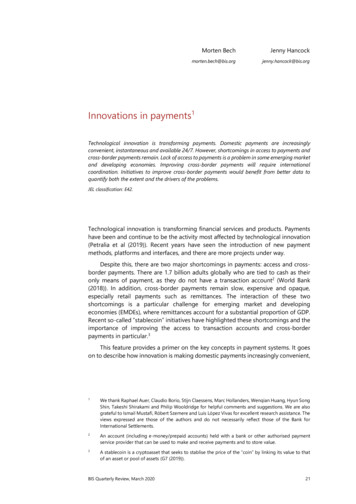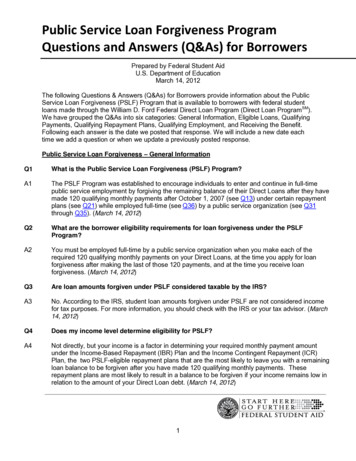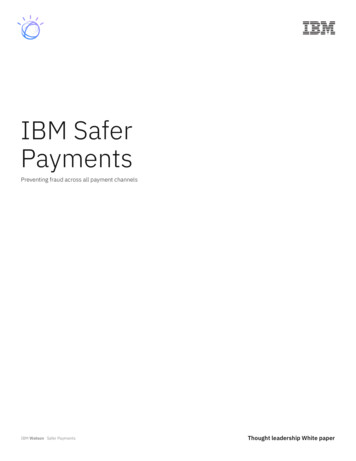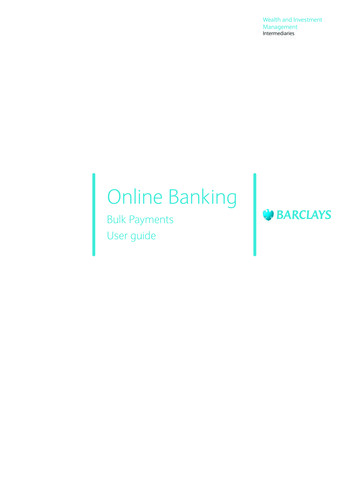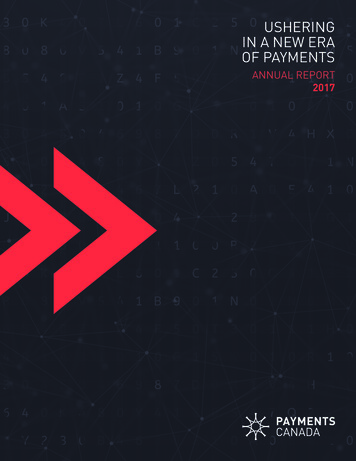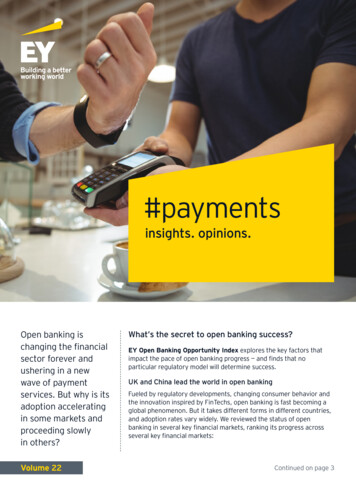
Transcription
#paymentsinsights. opinions.Open banking ischanging the financialsector forever andushering in a newwave of paymentservices. But why is itsadoption acceleratingin some markets andproceeding slowlyin others?Volume 22What’s the secret to open banking success?EY Open Banking Opportunity Index explores the key factors thatimpact the pace of open banking progress — and finds that noparticular regulatory model will determine success.UK and China lead the world in open bankingFueled by regulatory developments, changing consumer behavior andthe innovation inspired by FinTechs, open banking is fast becoming aglobal phenomenon. But it takes different forms in different countries,and adoption rates vary widely. We reviewed the status of openbanking in several key financial markets, ranking its progress acrossseveral key financial markets:Continued on page 3
EditorialI am delighted to present the latest edition of #payments, which coversa broad range of perspectives, as well as our coverage of merger andacquisition (M&A) and venture capital (VC) transaction activity.2018 was the year that open banking became a reality in many markets.Open banking — mandated in some geographies and driven by market forcesin others — provides a framework for banks to share their customer datawith third parties via application program interfaces (APIs). As a departurefrom historical models where customer data was screen-scraped or requiredcumbersome and insecure customer identification and authenticationprocedures, open banking makes data accessible securely and in real time.The end result for consumers is an enhanced experience that allows them toconsume digital financial services when they want, where they are, and withmore information, insight, and reliance. Our open banking feature, based onour EY Open Banking Opportunity Index, assesses the readiness of openbanking to thrive across key markets.Innovation is a key theme of this edition of our #payments newsletter. Weexplore how Europe’s second payment services directive (PSD2) is reshapingits banking sector, and the huge impact the introduction of General DataProtection Regulation (GDPR) is having on how companies must protect data.As financial institutions work to comply with both pieces of legislation, how arethey balancing innovation and protection?We also explore how value-added tax (VAT) symmetry can drive paymentsinnovation. The inconsistent application of VAT on payment services acrossEurope has created an uneven playing field for financial institutions and mayeven be hampering innovation. Is it time for all European countries to adoptVAT on payment services?We hope our #payments newsletter provides you with new insight into thepayments landscape and key developments in the industry.Best regards,Sara ElinsonEY Americas FinTech M&A and Payments M&A Leader03What’s the secret to open bankingsuccess?Open banking is transforming financialservices and ushering in a new wave ofpayment services. But why is its adoptionaccelerating in some markets andproceeding slowly in others?06How banks can balance GDPR andPSD2GDPR shouldn’t hamper the innovationpromised by PSD2. Actions for banks toachieve compliance without neglectinginnovation.09M&A activity and deal characteristicsThe fourth quarter of 2018 recorded theyear’s highest quarterly deal volume,with cross-border investments andconsolidation driving activity.11Venture capital funding activityDespite increasing global geopoliticaluncertainty, the fourth quarter of 2018delivered the highest number ofquarterly deals of the past two years.13Transaction overviewM&A and VC25EY Global Payments InvestorConference brings payments leaderstogether to discuss major industrytrendsIndustry consolidation and the innovationof new entrants were key themes. Whatother major trends are shaping thesector today — and what’s to come?
03#payments Volume 22What’s the secret to openbanking success?Continued from page 1871941025Overall globalrankingUKChinaSingaporeUSHong Kong SARAustraliaNetherlandsCanadaGermanySpainUnited KingdomThe UK ranked first in our Index, withsuccess due largely to the world’s mostprescriptive implementation of openbanking standards and industryinnovation. While mass adoption isprobably still three to five years away,strong regulatory direction andenthusiastic FinTechs set the scene fora positive open banking future.Consumer reluctance remains thebiggest hurdle, partly due to a culturalmindset, but also because of somehigh-profile data breaches. Read moreChinaChina (mainland) ranks second after theUK, though its laissez-faire regulatoryenvironment is a polar opposite of theUK. Rapid adoption rates are drivenby the enthusiasm of China’s fastexpanding digitally connected middle36class, which prefer to transact via theirphone — mobile banking has taken offfaster here than anywhere else. ReadmoreSingaporeSingapore ranks highly — third in ourIndex, though its organic approachto open banking so far is limited tothe traditional incumbent banks.Regulators are prioritizing the stabilityof the country’s financial sector overmandated openness; however, theapproach is not hindering strongrates of innovation. High trust amongconsumers signals further adoption.Read moreUSOpen banking is being shaped withouta strong regulatory mandate. Instead,the worlds’ highest rate of innovation,a thriving FinTech environment andfierce competition among banks placesthe US fourth in our Index. Strongconsumer sentiment bodes well forfuture success, though the hands-offapproach of regulators leaves banks towork out standards among themselves,which may potentially slow downprogress. Read moreHong KongIt’s a global financial hub, but HongKong SAR ranked only fifth in ourIndex. Progress should accelerate withthe introduction of a suite of financialinitiatives. These include the mandatedintroduction of application programinginterfaces (APIs), the entrance of virtualbanks and a faster payment systemto support less costly and immediatepayment transfers across ecosystemplayers. Read more
04Open bankingopportunity index#payments Volume 22AustraliaSpainIn 2019, Australia will begin a mandatedopen banking rollout. Its principles willalso extend to other industries, startingwith energy and telecommunications.But implementation may be slowand costly due to the need to reachagreement among a complicatedecosystem of regulators. Australianconsumers are positive about thepotential benefits, though they will needto be convinced that it is safe to sharedata with FinTechs. Read moreSpain lags its European neighbors inopen banking, partly due to governmentdelays in implementing PSD2. Butdespite ranking last in our Index,the potential looks positive. Spanishconsumers are relatively more willing toshare transactional data and the EU isset to transpose PSD2 intolaw over the next 12 months.NetherlandsOur Index results show that no singleregulatory model can determineThe Dutch sector ranks seventh foropen banking adoption, with regulatorydelays and consumer reluctancehindering its potential. But, the situationshould improve in 2019 as the Senatemoves to legislate the EU’s secondPayment Services Direction (PSD2),which is an important platform for openbanking in Europe. Winning the trustof consumers will be the biggestbarrier — our survey found only 18%of digitally active consumers willing toshare transaction data with FinTechs.Read moreCanadaIts “go slow” approach placed Canadaeighth in our Index, due mostly toregulatory caution and a lack ofconsumer enthusiasm. While regulatoryprogress is unlikely until the countryupdates its major privacy law, bankscan accelerate their own initiatives,particularly in coordinating internalinitiatives, opening their platforms toinnovators, and proactively promotingdigital adoption to consumers.Read moreGermanyIt’s a global leader in regulatoryreadiness, ranking second on thatpillar after the UK, though Germany’sstandards are not as prescriptive. Butdespite the positive environment, openbanking is yet to reach its potential heredue to consumer uncertainty around theconcept and cybersecurity concerns.No one regulatory formulafor successsuccess. Open banking is thriving in bothChina and the UK, which host vastlydifferent regulatory environments.The divergent approaches show theimportance of each market takingan individual approach to openbanking. Regulators, governmentsand the industry can learn lessonsfrom other markets. However, eachshould ultimately design a regulatoryframework and innovation initiativesthat suit their own financial sector andconsumer sentiment.UKMainland China A prescriptive model An organic model Banks mandated to use open APIs Open banking not mandated by legislation Mandatory API specifications andstandardized formats No mandatory API specifications, but thefinancial services industry is using open APIs Strong innovation environmentand adoption potential Strong adoption potential and innovationenvironment Consumers are cautious aboutsharing data Less data protection, but consumersare comfortable sharing data
05Open bankingopportunity index#payments Volume 22Consumer sentiment insights: market comparisonMarketNet tageAustralia37%40%57%3%China ds23%30%62%8%Canada22%31%59%9%Hong Kong vepercentageMarkets are listed by overall net sentiment percentage: The proportion of positive posts minus the proportion of negative posts.Source: EY Open Banking Opportunity Index; Consumer sentiment analysis conducted by Alva Insights.Is consumer trust the magicingredient for successfulopen banking?If regulatory action — or inaction — is noguarantee of widespread open bankingadoption, what is the secret of success?Index results reveal clues as to the keyingredients that drive high adoption,with consumer trust a major factor.Unless consumers feel safe sharing datawith financial institutions — and cansee a clear payoff for doing so — openbanking cannot thrive. But, our Indexfound that consumer trust remainslow or moderate in almost all of themarkets we surveyed, irrespectiveof the regulatory environment. Onlycustomers in Mainland China scorestrongly in their willingness to shareinformation with third parties — abouthalf say they are comfortable sharingtransaction data with FinTechs forbetter services.The issue of trust is a curious one tounderstand. Countries with the toughestregulatory regimes sometimes producethe most cautious consumers, whilethose with less controls express greaterenthusiasm for open banking. Culturalnorms play a big role, and are moredifficult to change, but regulatorscan help by continuing to build anenvironment that reassures consumerswithout stifling innovation.About the EY Open BankingOpportunity IndexThe EY Open Banking OpportunityIndex assesses the success of openbanking in select markets using fourkey pillars — regulatory conditions,adoption, consumer trust andinnovation. Success is viewed as thepotential for consumers to adoptopen-banking enabled serviceswithin a market.Innovation can accelerateadoptionIt’s this innovation that may ultimatelywin over consumers. It’s up to financialinstitutions to drive it, engageconsumers in the open bankingexperience and prove to them that thepros outweigh any perceived cons. It’sbeen done before — people willinglyshare information with social mediaapps when they think the benefitsmake it worthwhile, and because it’seasy and fun. Innovation by financialinstitutions, particularly in marketdriven environments such as the US,may convince consumers of the valueof open banking and accelerate itsadoption across global markets.For each of the pillars, we assesseda wide range of indicators todevelop insight into the conditionsin each market. We applied alower weighting to the regulatoryenvironment pillar. Unlike adoption,consumer trust and innovation,regulation is not a prerequisite forsuccess.EY open banking opportunity index2018 — methodology.Hamish Thomas
06#payments Volume 22How banks can balanceGDPR and PSD2PSD2 aims to create access to personal data, whileGDPR aims to protect it. When properly implemented inharmony, these legislations can enable banks to betterprotect and serve consumers, move beyond compliance,and seize new opportunities for growth.Europe’s second payment servicesdirective (PSD2) is reshaping itsbanking sector. At the same time,the introduction of the General DataProtection Regulation (GDPR) has hada huge impact on how companies mustprotect data. As financial institutionswork to comply with both pieces oflegislation, how can they balanceinnovation and protection?Conflicting approaches?PSD2 and GDPR both were introducedin 2018 as comprehensive sets oflegislation focusing on consumer data.However, despite these similarities,these regulations were developed fromvery different perspectives.PSD2 aims to create access topersonal data. Through its access toaccounts rule, PSD2 can gain entryto the financial data of consumers —or payment services users (PSUs) —allowing third parties to enter thepayments market and provide newaccount information and paymentinitiation services. These servicesare offered by account informationservices providers (AISPs) and paymentinitiation service providers (PISPs),respectively.GDPR aims to protect personal data,making it easier for consumers to knowwhere their data is being used and raiseobjections about its use.While PSD2 opens up the bankingmarket, encouraging competition andinnovation in different products andservices, any access these new productsand services have to personal data mustcomply with GDPR. Noncompliancecarries heavy fines and reputationaldamage. So far, most traditional bankshave prioritized the protection ofconsumer data over major plans toinnovate. But as more new players enterthe open market, they face a choice ofmere compliance or harnessing PSD2’sopportunities to create competitiveadvantage.Processing of PSUs’ data transfer requestsPSD1situationPSU or data subjectBank: data controllerAISP orPISP: dataprocessorPSD2situationPSU or data subjectBank: data controller
07Balancing PSD2and GDPR#payments Volume 22It all comes down to consentDespite their different aims, both PSD2and GDPR hinge on the issue of consent.GDPR rules that financial institutionscannot process consumer data withoutconsent, which must be obtainedunder specific conditions. While PSD2also legislates that “explicit consent”is necessary to provide services toconsumers, the concept is not definedand there is no suggestion that it hasthe same meaning as in GDPR. Thislack of clarity around consent presentsan issue to parties offering paymentservices as they juggle implementationof both legislations. The table belowsummarizes the key differences.Major areas of contentionConsent elementGDPRPSD21. Consumer consent to process data must be freelygiven and for specific purposes.2. Customers must be informed of their right towithdraw their consent.3. Consent must be “explicit” in the case ofsensitive personal data or trans-border dataflow.4. Data processing and sharing is explicitly requestedby the customer.5. Consent expires automatically.6. Consent must be clear, specific and informed.Notes: Conflicts between GDPR and PSD2 do not exist when the legitimate basis on which the processingof personal data is founded is other than consent, e.g., the existence of a contract.Data portability and APIsGDPR gives consumers the right to dataportability, allowing them to transferthe data they have provided to theirbank to AISPs and PISPs in a structured,commonly used and machine-readableformat.While PSD2 has no bias toward a certaintechnology, its regulatory technicalstandards recommend the use ofapplication programing interfaces(APIs) to share data with AISPs andPISPs. APIs can allow communicationstandardization across incumbent banksand AISPs or PISPs, but their successacross Europe will depend on whetherthere is agreement on these standards.Alternatively, screen scraping allowsAISPs and PISPs to access PSUs’ bankaccounts via their own credentials,obscuring the ability of banks to seewhether it is the PSU or a third partyaccessing the account. However, as thismethod has fewer access restrictionsthan APIs, it raises concerns oversecurity, making APIs the preferredfuture approach for banks.Silent party dataWhen financial institutions shareconsumers’ transaction data, this mayalso contain information from PSUs thathave not explicitly given their consentto the third party. This is referred to as“silent party data.”Let’s consider how this might work.31A consumer called Jonconducts regulartransactions with hisfriend Karin, reimbursingeach other for dinnersout, concert tickets andweekends away.2Karin decides to use a seriesoffered by an AISP, sharingher transaction data with athird party. Jon’s name andaccount number will beincluded as part of thatinformation.While Karin consented to share her information as required byGDPR — Jon did not. In this situation there is no agreementbetween Jon and the institution — so is it allowed to disclosethis silent party data?Currently the answer is not clear, but as authorities have notfollowed up with more guidance, it is anticipated that this issuewill not be problematic to the services an AISP can deliver, aslong as silent party data is only displayed and not abused. In thislight, profiling of silent parties without explicit consent might beconsidered an abuse of their data information.
08Balancing PSD2and GDPR#payments Volume 22Key action pointsFinancial institutions should not letGDPR hamper the innovation promisedby PSD2. Instead, they should actnow to confirm that new services andproducts are compliant with both piecesof legislation. Key action points include: Take care with automated decisions.GDPR prohibits profiling — theautomated processing of consumerdata to identify and evaluate personalfeatures. Banks increasingly useautomation to deliver value-addedservices, such as credit scoringand expenditure evaluation. Butmore significant decisions, such asrefusing someone a loan, can onlybe based on automated processingof personal data if the decision isbased on a legitimate reason; forexample, explicit consent, a contractor compliance with a legal obligation.Moreover, under GDPR, financialinstitutions must be able to justifyevery automated decision if asked bya consumer. Conduct data protection impactassessments. The nature of AISPsand PISPs requires them to processhigh volumes of personal data,making it highly likely that dataprotection impact assessments willbe necessary. Assessments shouldtake place prior to the processing offinancial data and serve to map therisks of processing data and definemitigating measures. Design data protection into newservices. AISPs and PISPs mustadhere to data protection both bydesign and default principles. Theseprinciples require service providersto think about the impact theirservices will have on data protectionbefore delivering them. Appropriatemeasures should be taken to achieveGDPR compliance and minimize theprocessing of data. Be ready to give consumersinformation about the use of theirdata. Data subjects have the rightto know whether their informationis being processed and, if so, toreceive a copy. When designingservices, providers need to takethese rights into account so they candeliver the appropriate informationwhen requested. If a PSU request isunfounded or excessive, AISPs andPISPs may charge a reasonable fee. Confirm you can erase all consumerdata, if requested. Consumers havethe right to ask a service providerto erase all the personal data that itholds for them in a timely manner. ForAISPs and PISPs, this is particularlyimportant in case the PSU withdrawsthe explicit consent on which theprocessing of personal data wasbased. When designing services,providers need to take these rightsinto account so they can deletepersonal data if requested.Jeroen van der KroftTony de BosMoving from obligations toopportunitiesPSD2 is set to give banksunprecedented opportunities in thepayment sector, primarily becauseof its access to accounts rule. WhileGDPR rules around privacy will needto be considered when developing newproducts or making changes, thesechallenges can be navigated with robustplanning and sufficient expertise. Whenproperly implemented in harmony,PSD2 and GDPR enable banks to betterprotect and serve consumers, movebeyond compliance and to seize newopportunitiesfor growth.Pieter KuijstenFriso Dikkers
09#payments Volume 22M&A activity anddeal characteristicsThe fourth quarter of 2018 recorded the year’s highestquarterly deal volume, with cross-border investments andconsolidation driving activity.Q4at a glance:56dealsannouncedUS 0.8b 14total deal value – downfrom US 1.3b in Q3184deals in 2018 —up from 178in 2017transactions withfinancial termsdisclosedCross-border deals dominateIn late January 2019, MasterCard alsoshowed interest in acquiring Earthport,recommending an offer that values thecompany at 233m (approximatelyUS 304m). At the time of publication, wewere yet to see Visa make a counteroffer,but share movement suggests this couldBusiness InsiderIndependent3 Global Newswire12Alternative investment market-listedBoku, the independent direct carrierbilling company, acquired a 100% stakein US-based Danal for US 112m,valuing the company at almost 20x LTMrevenue. Danal provides mobile businesssolutions, and its acquisition enablesBoku to accelerate the development ofits own mobile identity service offering,expand into new merchant segments andenhance its presence in keygeographies.3Also in the quarter, Irish companyTransferMate acquired a 100% stake inDevisenwerk AG, a global money transferplatform based in Switzerland. Thetransaction gives TransferMate use ofDevisenwerk AG’s Swiss paymentslicense, offering immediate market entryinto the Swiss payments market. This isan important sector for corporate fundsand investment banking for high-networth individuals.2Fig. 1: M&A market 10562017 Q42018 Q12018 Q2Number of transactions2018 Q30.82018 Q4Disclosed value (US bn)Source: EY analysis, Capital IQ, Mergermarket, company websites100Number of transactionsEarthport offers a lower-cost alternativeto traditional payments systems byallowing banks and money transfer firmsto form just one relationship with the firm,instead of multiple ties with variouspayments channels around the world. Thedeal would strengthen Visa’s cross-bordermoney transfer offering by helpingprovide faster and cheaper cross-bordermoney transfer service to customers.1be the case. We will provide an update onthis deal in the next edition of #Payments.Disclosed value (US b)One of the largest and most competitivedeals of Q4 highlights a broader industrytrend toward cross-border transactions.Visa announced the proposed acquisitionof a 100% stake in UK-based Earthport inan all-cash offer worth 198m(approximately US 259m), which valuedthe company at 5x its last 12-month(LTM) revenue.
10#payments Volume 22M&A activity roundupConsolidation continuesFig. 2: Median enterprise value multiplesThe trend to consolidate continued inQ4, as highlighted by the US 184macquisition by NCR Corporation of a100% stake in JetPay, a provider ofend-to-end payment processing andpayroll solutions. The deal between thetwo US-based companies values JetPayat 2.2x LTM revenue. The JetPayacquisition allows NCR to integrate acloud-based payments platform into itsenterprise point-of-sale (POS) solutionsfor retail and hospitality sectors, and isexpected to strengthen its product mixwhile driving recurring revenue growthand expanding margins.420x18.818x 16.416x16.215.114x12x10x10.48x6x4.04x 2.91.72x0x20142.72.320152016Revenue multiple20172018EBITDA multipleFull-year valuations dip slightlyTransaction multiples declined slightlyfor the full-year 2018. The medianearnings before interest, tax,depreciation and amortization (EBITDA)multiple fell from 16.2x in 20175 to 15.1xin 2018. The median revenue multiple forthe same period also decreased from4.0x to 2.7x, but it is well above the 2016level.Deals by region and segmentFig. 3: Targets by regionOutlook for 2019Looking ahead, geopolitical uncertaintyaround the world may shift short-terminvestment sentiment, as investors lookto gain more clarity. However, as marketparticipants continue to focus onstrategic opportunities, such as thegrowth of SMEs and the continueddigitalization of financial servicesproviders, we expect investment andtransaction activities to remain dynamic.NCR Press Releaseall deals in 20175 %AsiaNorth AmericaEuropeMiddle East, Africa (MEA)South AmericaAustraliaSource: EY analysis, Capital IQ, Mergerstat M&ADatabase, Company websitesAndreasHabersetzer42018Q45%In Q4, deal targets were based in: Asia-Pacific 30% North America 29% Europe 27%2%2%7%Fig. 4: Targets by segmentDawei WangPayment Acceptance Devices SoftwareAlternative payment systemsProcessingMoney transferSecurityCouponing/LoyaltyIssuingData analytics
11#payments Volume 22Venture capital fundingactivityDespite increasing global geopolitical uncertainty, thefourth quarter of 2018 delivered the highest number ofquarterly deals of the past two years.Q4at a glance:797%US 3.3b US 1.2bannouncedinvestmentsin paymentsincrease in dealvolume from Q3deal value – almostdouble compared toQ3 (US 1.8b)28%of funding was invested inpayment acceptance devices andInvestors focus on growthpotential of emerging marketsIn Q4, almost half of all transactionswere led by investors based in Northand Central America (49%), followed byEurope (27%) and Asia-Pacific (19%).Asia-Pacific was the most attractivetarget, accounting for about 45% oftotal transaction value, with North andCentral America attracting 40% andEurope 12%.The high level of funding inAsia-Pacific indicates that investorsremain positive on future growthin emerging economies across theregion. They are also encouraged byother factors driving greater adoptionof electronic payments, includingfavorable demographics, the push forfinancial inclusion, regulatory changesthat support electronic paymentmethods, FinTech innovation and agradual increase in the adoption ofalternative payment methods.investment in Go-Jekwas the biggest dealof Q425%of funding was targetedtoward processing servicesThe quarter’s largest deal — Indonesianfirm Go-Jek’s US 1.2b fundingfrom Tencent Holdings, JD.com andGoogle — illustrates the appeal of AsiaPacific innovation. Go-Jek began as amotorbike ride-hailing company but hassince expanded to offer regular taxis,shopping on-demand and a mobilepayment service — Go-Pay — whichis also being promoted as an offlineoption. Go-Pay allows consumers topay for services via a prepaid account.This investment is expected to helpGo-Jek to expand in the region and formstrategic alliances.Equity funds focus on seedinvestmentsMost funding of Q4 was contributedby equity investors, with much of theactivity focused on early stage and seedinvestments.In a major deal of the quarter,US-based Brex raised US 125m ata valuation of US 1.1b from DSTGlobal, Greenoaks Capital Partners andInstitutional Venture Partners. Thisbrings Brex’s total funding to date to anestimated US 180m. Founded in 2017,Brex provides corporate credit cardsto start-ups with streamlined expensemanagement and reporting, andwithout requiring a personal guaranteeor deposit. This latestround of funding will be used tooffer a reward program tailored to theneeds and spending patterns of Brexcustomers and to expand its productand services to companies outside ofthe technology sector.Mobile money transfers andmobile wallets expectedto increaseA notable trend observed in the VCinvestment landscape is the increasingprominence and rising acceptance ofnew payment channels, particularly
#payments Volume 22mobile money transfers. Advancedauthentication methods such astokenization and biometrics are makingthese new payment channels moresecure. The US 80m funding of SouthKorean P2P mobile payment platformToss was led by Kleiner Perkins andRibbit Capital, valuing the firm atapproximately US 1.2b, making itSouth Korea’s first FinTech unicornand highlighting investor appetite in(mobile) P2P transfers.VC activity roundupFig. 5: Venture capital deal16,000Disclosed value (US m)As the industry moves to a collaborativeecosystem, the adoption of mobilewallets is expected to gain prominencein support of integrated and seamlesspayment experiences. More paymentfirms, including banks, payment serviceproviders and card networks areimplementing mobile wallet solutionsand global card networks. Visa,Mastercard and American Express havealso rolled out digital wallet services,such as Visa Checkout, Masterpass andAmex Express Checkout.569206662,00092201341,5001,168102017 Q4ProcessingSecurity2018 Q212018 Q32018 Q40Disclosed value (US m)Includes US 14.0b funding raised by Ant Financial from Temasek Holdings, GIC and other investorsFig. 6: Number of deals by funding stage (in %)1925741416241155397159185861520143027282018 Q22018 Q32018 Q491934372017 Q42018 Q1Venture/seed25Series ASeries B41%9Series CSeries D/EOther121081011140%4%42432018 Q22018 Q3282018 Q4Alternative payment systemsIssuingMoney transferOthers1Includes ATM, Couponing/Loyalty and Data analytics2018 Q419%14Payment acceptance devices1.2018 Q12018 Q349%25442018 Q120Number of investments1.232017 Q4301,0411,00008237401,783Fig. 8: Investment by region (in %)15195053Fig. 7: Investment by sectors (in %)460500We expect investment to continuein alternative payment systems andpayment acceptance devices suchas mobile point of sale (mPOS). Asinvestors seek scale and expand theirreach, the sector’s most dominantinvestors, such as Tencent Holdings andTemasek Holdings, are likely to increasetheir in
concept and cybersecurity concerns. Spain Spain lags its European neighbors in open banking, partly due to government delays in implementing PSD2. But despite ranking last in our Index, the potential looks positive. Spanish consumers are relatively more willing to share transactional data and the EU is set to transpose PSD2 into

